Nikola Benin, Ph.D

Jean-Honoré Fragonard, The Stolen Kiss, late 1780s. Image via Wikimedia Commons.
The art of seduction has been disgracefully debased in these last few decades. Recently, it’s been reduced to the rather uncivilized mating call “Netflix and chill,” an insinuation of sex sans flirtatious preamble—or any effort at all. Must our standards for romance be so low? Our regard for the pleasures of temptation and delayed gratification so warped by modern technologies?
Let this Valentine’s Day offer a much-needed reminder to take note of paramours past. As the French constantly remind us, there’s no better teacher for a masterclass in love. In the 18th century “age of allurement,” these coquettish enfants terrible practically invented erotic play with seduction techniques that reached dizzying extremes.
Today we might think of seduction as a series of finite actions (sit on couch, load Netflix, euphemistically “chill”) that, without much additional preparation, can lead to the one ultimate goal (sex). But to the refined
lover, seduction was part of an elaborate game of cultivated sociability in which pleasurable experiences were mediated by equally pleasurable, luxurious environments.
lover, seduction was part of an elaborate game of cultivated sociability in which pleasurable experiences were mediated by equally pleasurable, luxurious environments.

Claude Hoin, Interior with a Portrait of a Young Lady Before a Bust, 1788. Courtesy of the Art Institute of Chicago.
In the upper echelons of 18th-century French society, a sophisticated taste in interior decoration underlaid immense social—and sensual—power. Not much has changed, in the sense that high-end decor can signal a refined sensibility—as well as, of course, a big bank account. Indeed, the extravagantly luxurious lifestyle cultivated among the elite during this time is exemplified by fashion, furniture, and objets d’art so ridiculously opulent that they seem to explain the proletariat revolution with a single glance.
But such vanities played an integral role in facilitating both status and pleasure—a state, as Mimi Hellman writes in her excellent 1999 essay “Furniture, Sociability, and the Work of Leisure in Eighteenth-Century France,” that was a kind of “social currency.” One catalyzed pleasure first with social graces by delighting company with a carefully cultivated charm, and secondly, by flawlessly executing proper etiquette, especially in creating elegant gestures while handling complex furnishings. The third—and perhaps most crucial—step was to craft perfectly sumptuous interiors: one’s premiere stage for social performance.
In this arena, courtship was conceived not as “a pursuit of overt sexual expression, but rather an exchange in which individuals sought to engage and delight each other with an artfully conducted repertoire of pleasing poses, gestures, expressions, and conversation,” Hellman writes in the catalogue for “Dangerous Liaisons: Fashion and Furniture in the 18th century,” a 2004 exhibition at the Metropolitan Museum of Art. The inventive show elucidated these intimacies through a choreographed interplay of fashion, furniture, and the decorative arts. In the Wrightsman Galleries period rooms, curators arranged erotically charged vignettes—a stolen caress during a music lesson; a flirtatious glance while playing cards—with mannequins styled in silk boutonnieres and flowering robes à la Française.
The exhibition was not only an enticing display of treasures normally isolated in separate curatorial departments, it was also an opportunity to appraise the domestic interior—and the centrality of luxurious things—to the concept of elite identity in France. The Louis XVI–style period rooms in the Wrightsman Galleries capture the self-indulgent atmosphere inherent to the time period, when fashion and furniture were intended to not only delight, but arouse. Each room offers a holistic sensory experience, with walls covered in carved paneling or expensive textiles; gleaming mirrors that frame marble mantelpieces and reflect curving, gilded-bronze chandeliers and porcelain vases; and matching sets of silk-upholstered chairs, each designed for specialized leisurely activity. The complex mechanisms and rules for gracefully maneuvering such decorations, however, provided opportunities to show off beguilingly sophisticated charm (or a stockinged ankle)—as well as the potential for embarrassing blunders that would reveal a discomfort with the codified leisure of the nobility.
“Objects were like extensions of the body, part of a wardrobe that, correctly worn, could turn the activities of elite existence into dances of artful persuasion,” Hellman writes in “Interior Motives: Seduction by Decoration in Eighteenth-Century France.” The literature of the time reflects this libertine attitude. In Jean-François de Bastide’s odd erotic novella “The Little House: An Architectural Seduction,” which inspired the Met show, the oily Marquis de Trémicour relies on the power of the luxurious objects that adorn his maison de plaisance to woo the women he brings home.
In this tale, the marquis has ensnared the young and innocent Mélite. As he gives her a tour of the house, Mélite feels her resolve weaken through evermore elegantly appointed rooms. (“Indeed, so voluptuous was this salon that it inspired the tenderest feelings, feelings that one believes one could have only for its owner.”) Mélite becomes so distraught by the beauty of the house and the marquis’s impending advances that she almost collapses onto a bergère, an upholstered armchair that offers the wily Trémicour the opportunity to get closer to her. He throws “himself at her knees,” trapping her in his gilded cage until she finally loses “the wager” and sleeps with him.
As an aristocrat, Mélite is accustomed to luxurious things. However, this petite maison, like many of the period, employs nature as a sublime motif to visually overwhelm her. The many picture windows display views of the vast, meticulously designed gardens, while mirrors infinitely reflect the grounds, giving the impression of being surrounded by nature.
The romantic aspect of the natural world is likewise revealed in contemporary painting. In
’s famous The Swing (ca. 1767–68), towering trees and rose bushes encircle a flirtatious young woman who, while swinging, allows an intruding young man in the bushes to peek up her skirts. The garden is a pleasurable place: beautiful, colorful, fragrant, secluded, and quiet—the perfect setting for a rendezvous. Decorations inside the home, therefore, would also mimic this theme.
’s famous The Swing (ca. 1767–68), towering trees and rose bushes encircle a flirtatious young woman who, while swinging, allows an intruding young man in the bushes to peek up her skirts. The garden is a pleasurable place: beautiful, colorful, fragrant, secluded, and quiet—the perfect setting for a rendezvous. Decorations inside the home, therefore, would also mimic this theme.
Every element of the Marquis de Trémicour’s house is designed to insinuate romance by stimulating all of the senses; various decorative elements were meant to harmonize with the room’s other adornments for a synesthetic effect that could render a woman like Mélite helpless. In his water closet, for instance, there are “urns and porcelains filled with fragrances…placed artistically on stands.” Potpourri bowls and perfumers were part of a larger experiment in the overall sexualization of objects.
Interacting with one such porcelain potpourri bowl creates a sensuously intimate moment. Imagine if Mélite were to pick one up: She would feel the curves of the gilt-bronze handles cast with curling leaves, and the smooth, glassy porcelain painted with flowering plants. If she were to remove the cover, the strong scent of dried flowers and spices would reach her nose, the aroma furthering the feeling of the outdoors coming inside. Without the bombard of visual, somatic, and olfactory pleasures, the impressionable woman may have found the resolve to leave the Marquis de Trémicour’s house with her virginity intact. But ultimately, the objects and the beautiful woman herself reinforce and highlight one another’s seductive qualities. Indeed, Hellman perceives that among the 18th-century elite, “objects possessed many of the same surface qualities as the richly clothed bodies of their users.”
That story, however, might feel like one of unequal exchange, an innocent young woman at the mercy of a wealthy older man who proclaimed his power—and virility, apparently—vis-à-vis his impeccable taste. But “a condition that was fundamental to social experience in eighteenth-century France,” Hellman elucidates in “Furniture, Sociability, and the Work of Leisure,” was “the double position of viewing and being viewed.”
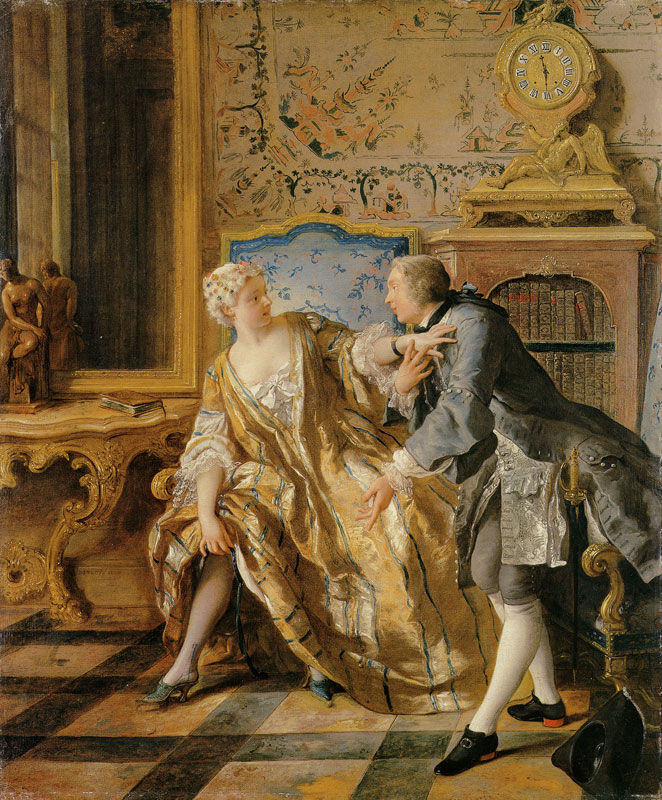
Jean François de Troy, The Garter, 1724. Image via Wikimedia Commons.
Take the fireplace, the central decorative element in any fashionable room. The mantelpiece would showcase decorative accouterments like porcelain vases and automated clocks, and an overmantel mirror would reflect these treasures while also casting sparkling light from candles and glittering chandeliers. Artfully placed mirrors had the added benefit of giving people who gathered around the fireplace the ability to observe who was entering or leaving the room, without having to turn their heads. A peacocking woman in a silk gown standing before the mirror could show off her beauty with a practiced effortlessness: She could be observed by others in the room while she, in turn, could glance coyly back at them.
The aristocracy of 18th-century France certainly had style and flair—but also a lot of rules. In this era of loosening sexual mores, the French managed to articulate and master an elaborately coded art of seduction while also voiding it of any spontaneity or joy. Be grateful that the confines of romance have widened, but be vigilant, too. No, you don’t have to be mega-rich to emulate the cat-and-mouse ethos of the Rococo, but some strategically placed mirrors, mood lighting, eau de cologne, and a strong appreciation for good conversation and the finer things can go a long way in transforming the everyday into a series of seductive encounters.

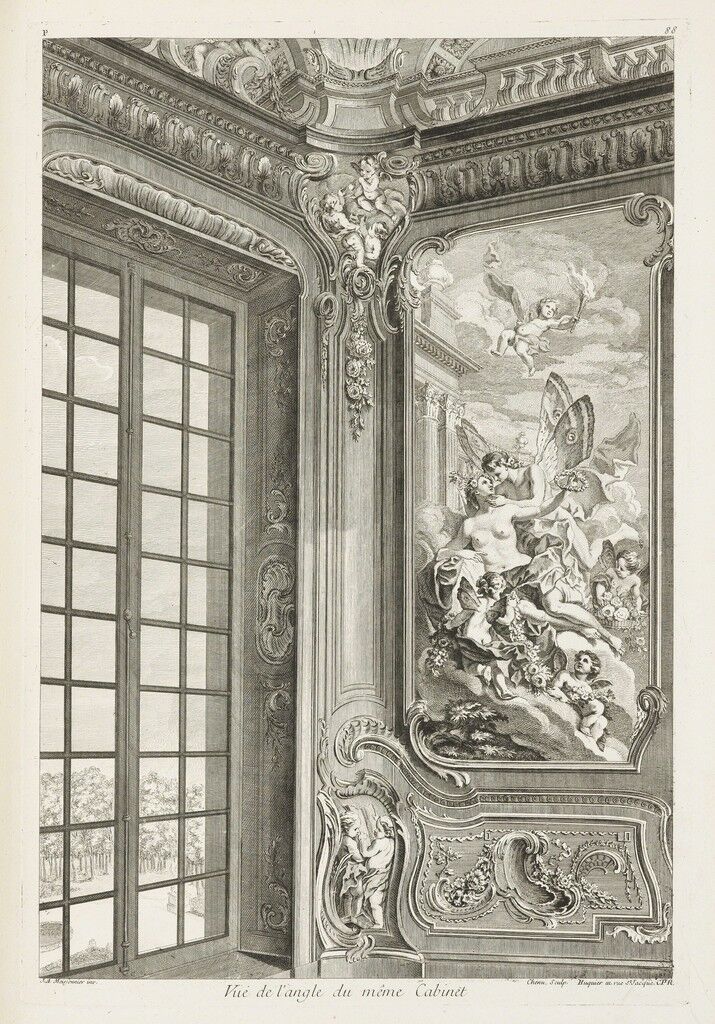
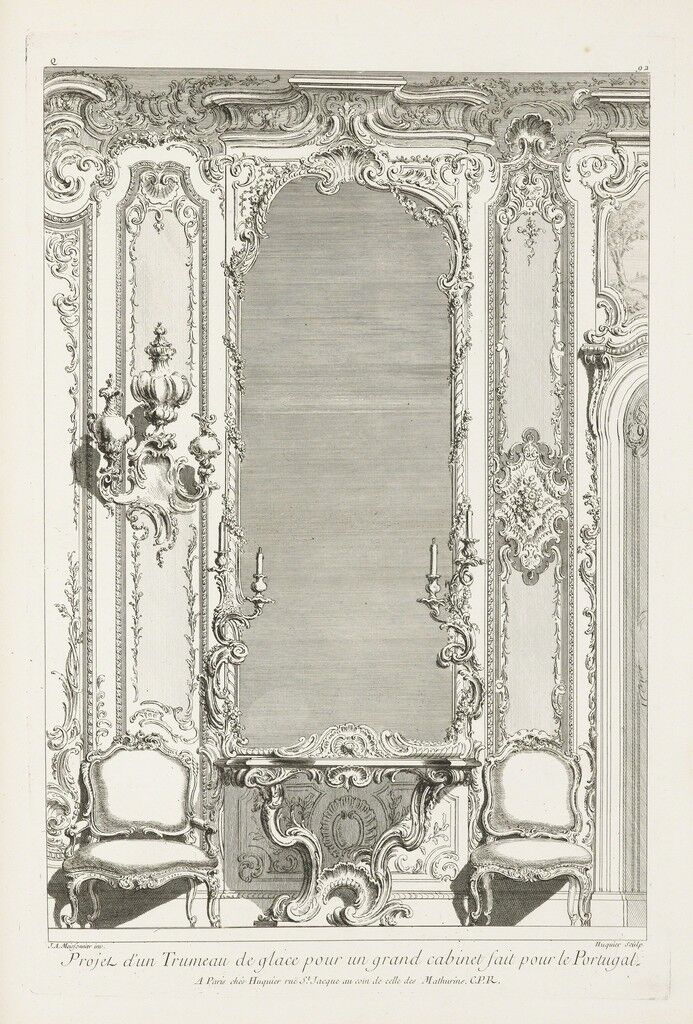
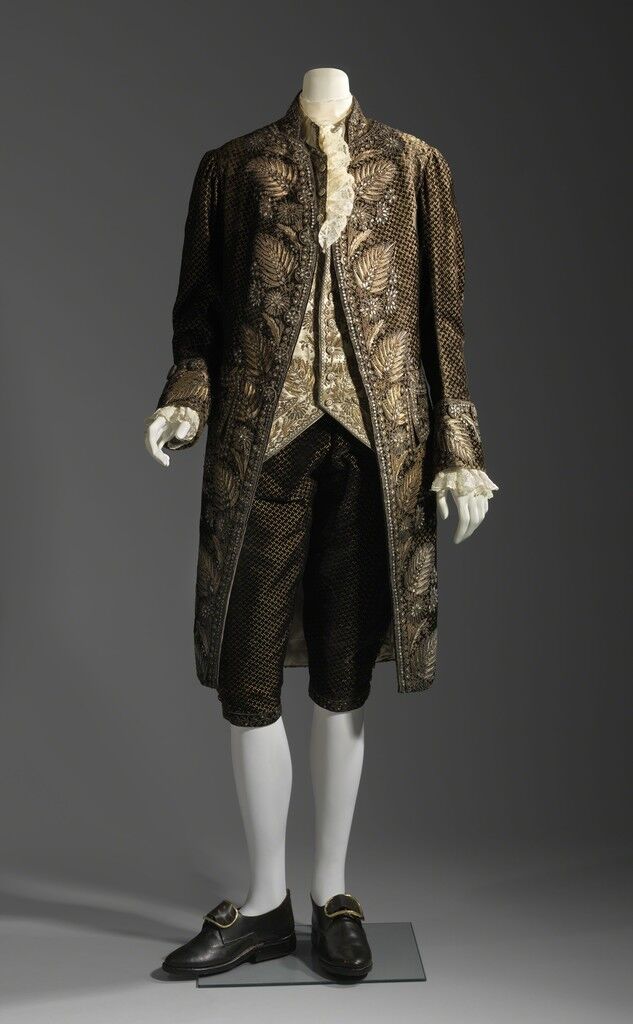

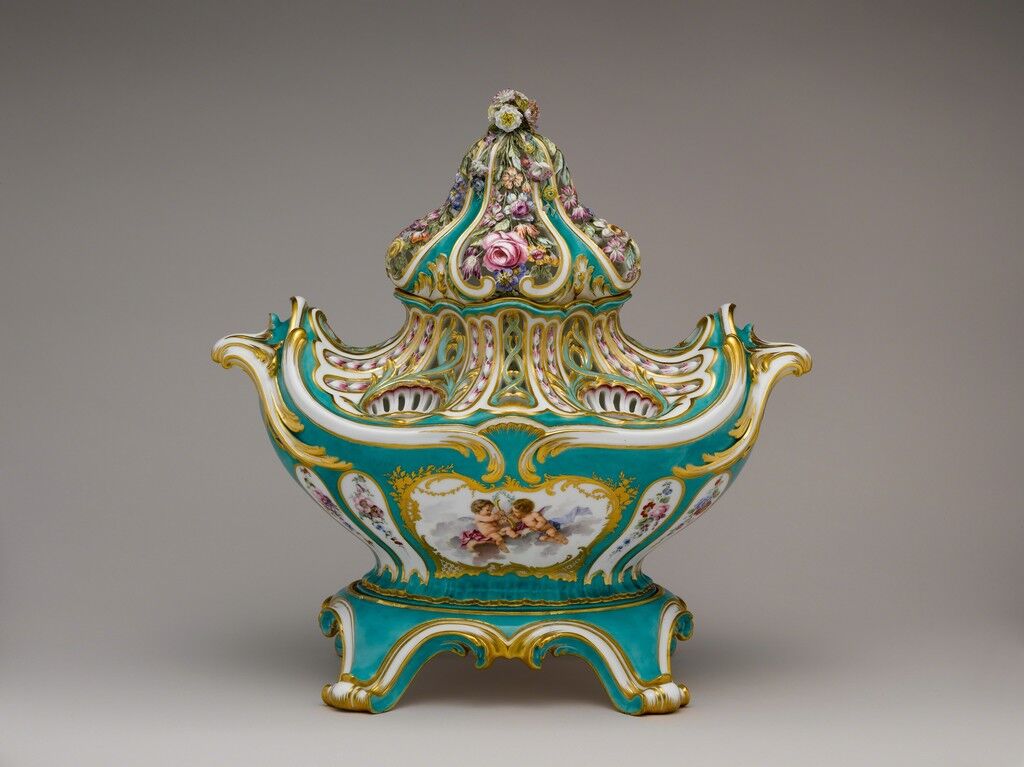
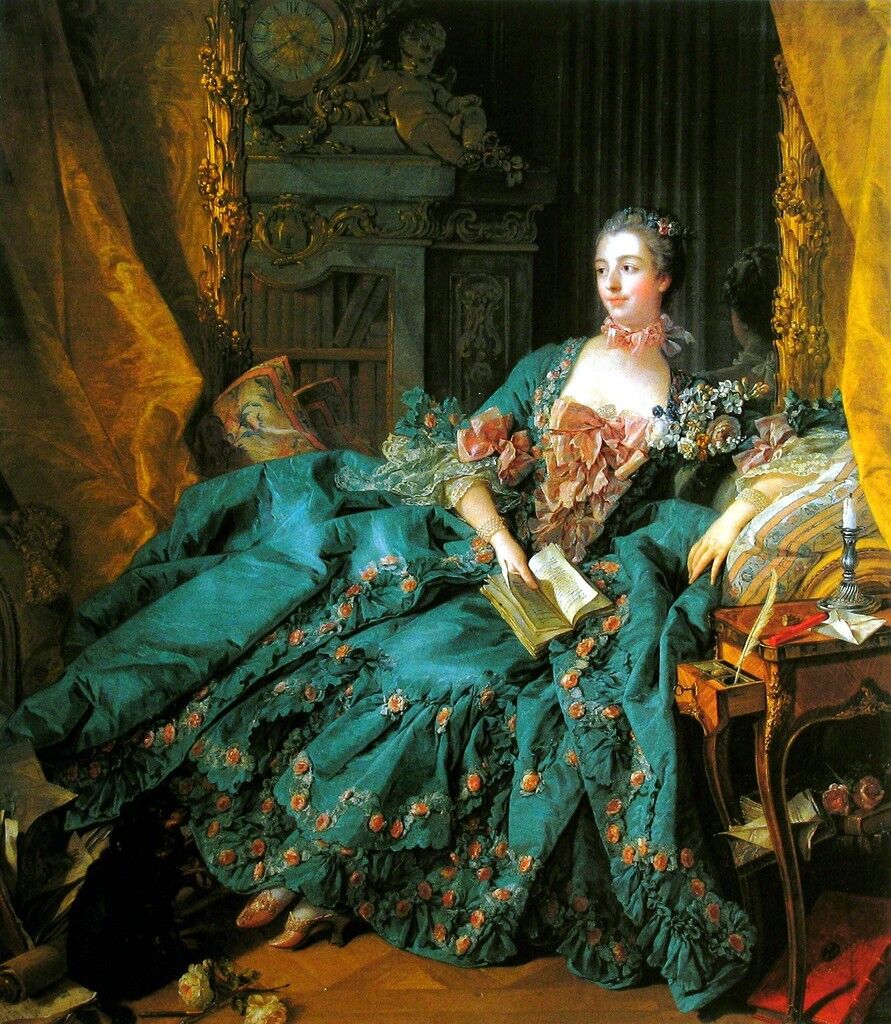
Няма коментари:
Публикуване на коментар